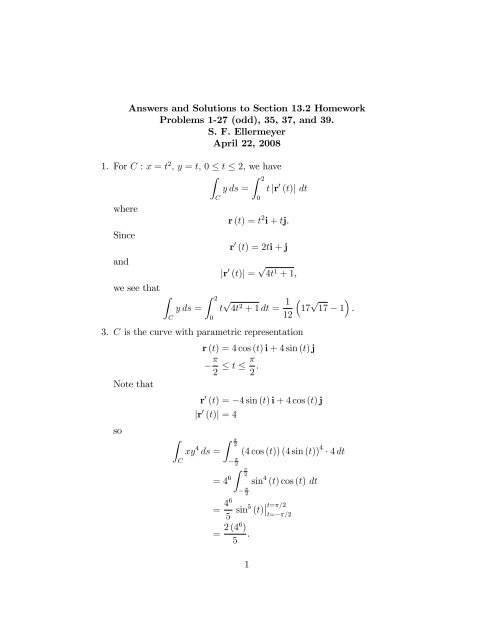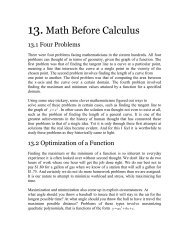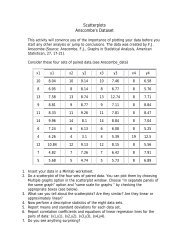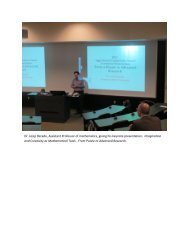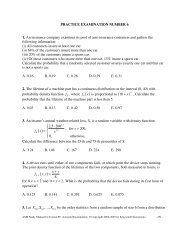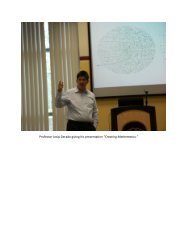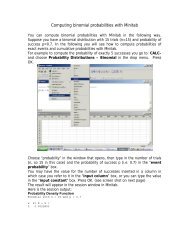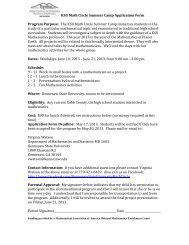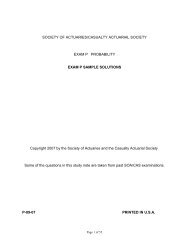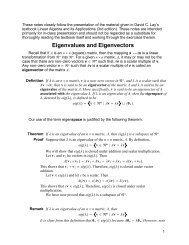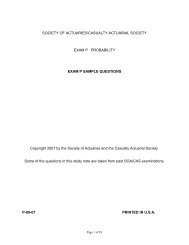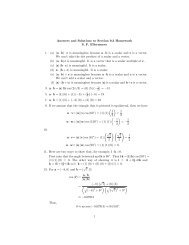Answers and Solutions to Section 13.2 Homework Problems 1"27 ...
Answers and Solutions to Section 13.2 Homework Problems 1"27 ...
Answers and Solutions to Section 13.2 Homework Problems 1"27 ...
You also want an ePaper? Increase the reach of your titles
YUMPU automatically turns print PDFs into web optimized ePapers that Google loves.
<strong>Answers</strong> <strong>and</strong> <strong>Solutions</strong> <strong>to</strong> <strong>Section</strong> <strong>13.2</strong> <strong>Homework</strong><br />
<strong>Problems</strong> 1-<strong>27</strong> (odd), 35, 37, <strong>and</strong> 39.<br />
S. F. Ellermeyer<br />
April 22, 2008<br />
1. For C : x = t2 ; y = t; 0<br />
Z<br />
t 2, we have<br />
Z 2<br />
y ds = t jr 0 (t)j dt<br />
where<br />
Since<br />
<strong>and</strong><br />
we see that Z<br />
C<br />
y ds =<br />
Z 2<br />
0<br />
C<br />
0<br />
r (t) = t 2 i + tj.<br />
r 0 (t) = 2ti + j<br />
jr 0 (t)j = p 4t 1 + 1,<br />
t p 4t 2 + 1 dt = 1<br />
12 17p 17 1 .<br />
3. C is the curve with parametric representation<br />
Note that<br />
so<br />
Z<br />
C<br />
r (t) = 4 cos (t) i + 4 sin (t) j<br />
2<br />
t<br />
2 .<br />
r 0 (t) = 4 sin (t) i + 4 cos (t) j<br />
jr 0 (t)j = 4<br />
xy 4 Z<br />
2<br />
ds = (4 cos (t)) (4 sin (t)) 4 4 dt<br />
= 4 6<br />
2<br />
Z<br />
2<br />
2<br />
sin 4 (t) cos (t) dt<br />
= 46<br />
5 sin5 t= =2<br />
(t) t= =2<br />
= 2 (46 )<br />
.<br />
5<br />
1
5. In this problem, the curve of integration (C) consists of the line segments<br />
C1 : x = t; y = 0, 0 t 2<br />
<strong>and</strong><br />
C2 : x = 2 + t; y = 2t; 0 t 1.<br />
Note that for C1, we have dx = dt; dy = 0, <strong>and</strong> for C2 we have dx = dt,<br />
dy = 2 dt. Thus<br />
Z<br />
Z<br />
Z<br />
xy dx + (x y) dy = xy dx + (x y) dy + xy dx + (x y) dy<br />
C<br />
7. For the curve<br />
we have<br />
so Z<br />
C<br />
9. For the curve<br />
= 0 +<br />
=<br />
C1<br />
Z 1<br />
Z 1<br />
0<br />
= 17<br />
3 .<br />
0<br />
C2<br />
(2 + t) (2t) dt + (2 + t 2t) 2 dt<br />
2t 2 + 2t + 4 dt<br />
r (t) = 4 sin (t) i + 4 cos (t) j+3tk<br />
0 t<br />
2 ,<br />
r 0 (t) = 4 cos (t) i 4 sin (t) j+3k<br />
jr 0 (t)j = 5<br />
xy 3 Z =2<br />
ds = (4 sin (t)) (4 cos (t)) 3 5 dt = 320.<br />
0<br />
r (t) = ti + 2tj + 3tk<br />
0 t 1<br />
2
we have<br />
so Z<br />
C<br />
xe yz ds = p 14<br />
r 0 (t) = i + 2j + 3k<br />
jr 0 (t)j = p 14<br />
Z 1<br />
0<br />
te 6t2<br />
dt =<br />
p 14<br />
11. (This is di¤erent from the problem 11 in the book.) The curve of<br />
integration (C) consists of the line segments<br />
12<br />
C1 : x = 0; y = t; z = t; 0 t 1<br />
e 6<br />
1 .<br />
C2 : x = t; y = 1 + t; z = 1 + 2t; 0 t 1<br />
C3 : x = 1; y = 2; z = 3 + t; 0 t 1.<br />
The di¤erentials on these curves are<br />
For the curve C1 we have<br />
Z<br />
z 2 dx z dy + 2y dz =<br />
C1<br />
For the curve C2 we have<br />
Z<br />
z 2 dx z dy + 2y dz =<br />
C2<br />
C1 : dx = 0; dy = dt; dz = dt<br />
C2 : dx = dt; dy = dt; dz = 2 dt<br />
C3 : dx = 0; dy = 0; dz = dt.<br />
=<br />
=<br />
Z 1<br />
0<br />
Z 1<br />
0<br />
Z 1<br />
0<br />
= 25<br />
3 .<br />
Z 1<br />
0<br />
t dt + 2t dt =<br />
Z 1<br />
0<br />
t dt = 1<br />
2 .<br />
(1 + 2t) 2 dt (1 + 2t) dt + 2 (1 + t) 2 dt<br />
(1 + 2t) 2 dt (1 + 2t) dt + 2 (1 + t) 2 dt<br />
4t 2 + 6t + 4 dt<br />
3
For the curve C3 we have<br />
Z<br />
z 2 dx z dy + 2y dz =<br />
Thus Z<br />
C<br />
C3<br />
Z 1<br />
0<br />
4 dt = 4.<br />
z 2 dx z dy + 2y dz = 1 25 77<br />
+ + 4 =<br />
2 3 6 .<br />
13. This is di¤erent from the number 13 in the book.<br />
(a) The curve C1 is<br />
Thus<br />
Therefore Z<br />
C1<br />
r (t) = 3i + (6t 3) j<br />
0 t 1.<br />
F dr =<br />
r 0 (t) = 6j.<br />
Z 1<br />
0<br />
F (r (t)) 6j dt.<br />
Since the vec<strong>to</strong>r 6j makes an acute angle with any of the vec<strong>to</strong>rs<br />
F (r (t)), 0 t 1, the dot product F (r (t)) 6j is positive for all<br />
t such that 0 t 1, meaning that the integr<strong>and</strong> is a positive–<br />
valued function of t. Therefore<br />
Z<br />
F dr > 0.<br />
(b) The curve C2 is<br />
Thus<br />
Therefore<br />
Z<br />
C2<br />
F dr =<br />
C1<br />
r (t) = 3 cos (t) i + 3 sin (t) j<br />
0 t 2 .<br />
r 0 (t) = 3 sin (t) i + 3 cos (t) j.<br />
Z 1<br />
0<br />
F (r (t)) ( 3 sin (t) i + 3 cos (t)) dt.<br />
4
Recall that, since r (t) is a circle, the tangent vec<strong>to</strong>rs r 0 (t) are<br />
orthogonal <strong>to</strong> this circle. However, the circle is oriented counterclockwise<br />
<strong>and</strong> the vec<strong>to</strong>rs of the vec<strong>to</strong>r …eld F are all pointing the<br />
the clockwise direction. In fact, it appears that the angle between<br />
F (r (t)) <strong>and</strong> r 0 (t) is equal <strong>to</strong> 180 for each t: This means that the<br />
integr<strong>and</strong> F (r (t)) r 0 (t) is a negative–valued function for each t<br />
such that 0 t 2 . Therefore<br />
Z<br />
C2<br />
F dr < 0.<br />
15. (This is di¤erent from the number 15 in the book.) For<br />
19. For<br />
we have<br />
Thus, for the vec<strong>to</strong>r …eld<br />
we have<br />
Therefore<br />
we have<br />
r (t) = t 2 i t 3 j, 0 t 1,<br />
r 0 (t) = 2ti 3t 2 j.<br />
F (x; y) = x 2 y 3 i y p xj<br />
F (r (t)) r 0 (t) = t 13 i + t 4 j 2ti 3t 2 j = 2t 14<br />
Z<br />
C<br />
F dr=<br />
=<br />
Z 1<br />
0<br />
Z 1<br />
0<br />
= 59<br />
105 .<br />
F (r (t)) r 0 (t) dt<br />
2t 14<br />
3t 6 dt<br />
r (t) = t 3 i t 2 j + tk, 0 t 1,<br />
r 0 (t) = 3t 2 i 2tj + k.<br />
5<br />
3t 6 .
Thus, for the vec<strong>to</strong>r …eld<br />
we have<br />
F (x; y; z) = sin (x) i + cos (y) j+xzk<br />
F (r (t)) r 0 (t) = sin t 3 i + cos t 2 j+t 4 k 3t 2 i 2tj + k<br />
Therefore<br />
Z<br />
C<br />
F dr=<br />
= 3t 2 sin t 3<br />
=<br />
Z 1<br />
0<br />
Z 1<br />
0<br />
= 6<br />
5<br />
F (r (t)) r 0 (t) dt<br />
3t 2 sin t 3<br />
2t cos t 2 + t 4 .<br />
cos (1) sin (1) .<br />
2t cos t 2 + t 4 dt<br />
21. The vec<strong>to</strong>r …eld F (x; y) = (x y) i + xyj <strong>and</strong> curve are shown below.<br />
32123<br />
32123<br />
6
Since the curve is traversed counterclockwise, it appears that the tangent<br />
vec<strong>to</strong>rs <strong>to</strong> the curve are mostly pointing in the same general direction<br />
as the vec<strong>to</strong>rs of the vec<strong>to</strong>r …eld. We thus suspect that the line<br />
integral will be positive. We now evaluate the integral. Since the curve<br />
C is given by<br />
we have<br />
<strong>and</strong><br />
r (t) = 2 cos (t) i + 2 sin (t) j<br />
0 t<br />
3<br />
2<br />
r 0 (t) = 2 sin (t) i + 2 cos (t) j<br />
F (r (t)) r 0 (t) = ((2 cos (t) 2 sin (t)) i + 4 sin (t) cos (t) j) ( 2 sin (t) i + 2 cos (t) j)<br />
Thus<br />
Z<br />
F dr =<br />
C<br />
=<br />
= 4 sin (t) cos (t) + 4 sin 2 (t) + 8 cos 2 (t) sin (t) .<br />
Z 3 =2<br />
0<br />
Z 3 =2<br />
0<br />
= 2<br />
+ 3 .<br />
3<br />
F (r (t)) r 0 (t) dt<br />
4 sin (t) cos (t) + 4 sin 2 (t) + 8 cos 2 (t) sin (t) dt<br />
25. The portion of the astroid in the …rst quadrant is shown here. It is<br />
traced out as t ranges from 0 <strong>to</strong> =2.<br />
7
1.5 1.0 0.5 0.5 1.0 1.5 1.5 1.0 0.5 0.5 1.0 1.5<br />
Since<br />
we see that<br />
<strong>and</strong> thus<br />
Z<br />
r 0 (t) = 3 cos 2 (t) sin (t) i + 3 sin 2 (t) cos (t) j,<br />
jr 0 (t)j =<br />
x<br />
C<br />
3 y 5 ds =<br />
q<br />
9 cos 4 (t) sin 2 (t) + 9 sin 4 (t) cos 2 (t)<br />
= 3 sin (t) cos (t)<br />
Z =2<br />
0<br />
Z =2<br />
= 3<br />
=<br />
0<br />
945<br />
16; 777; 216<br />
cos 3 (t) 3 sin 3 (t) 5 (3 sin (t) cos (t)) dt<br />
cos 10 (t) sin 16 (t) dt<br />
(This integral was computed by Maple.)<br />
8
29. (a)<br />
x = 1<br />
Z<br />
m<br />
y = 1<br />
m<br />
z = 1<br />
m<br />
Z<br />
Z<br />
C<br />
C<br />
C<br />
x (x; y; z) ds<br />
y (x; y; z) ds<br />
z (x; y; z) ds<br />
(b) For the helical wire C : x = 2 sin (t) ; y = 2 cos (t) ; z = 3t;<br />
0 t 2 <strong>and</strong> the density function (x; y; z) = k (constant),<br />
the <strong>to</strong>tal mass of the wire is<br />
Z<br />
m =<br />
ZC<br />
(x; y; z) ds<br />
= k ds<br />
= k<br />
= k<br />
C<br />
Z 2<br />
0<br />
Z 2<br />
0<br />
= 2 p 13 k<br />
jr 0 (t)j dt<br />
p 13 dt<br />
<strong>and</strong> the center of mass is at (x; y; z) where<br />
Z 2<br />
1<br />
x =<br />
2 p 13 k<br />
1<br />
y =<br />
2 p 13 k 0<br />
1<br />
z =<br />
2 p 13 k 0<br />
= 3<br />
Z 2<br />
t dt<br />
2 0<br />
= 3<br />
(2 )2<br />
4<br />
= 3 .<br />
0<br />
Z 2<br />
Z 2<br />
9<br />
k (2 sin (t)) p 13 dt = 0<br />
k (2 cos (t)) p 13 dt = 0<br />
k (3t) p 13 dt
31. The work done by the force …eld<br />
F (x; y) = xi+ (y + 2) j<br />
in moving an object along an arch of the cycloid<br />
r (t) = (t sin (t)) i+ (1 cos (t)) j<br />
(corresponding <strong>to</strong> the positive t direction for 0 t 2 ) is<br />
Z Z 2<br />
F dr = F (r (t)) r 0 (t) dt.<br />
Since<br />
<strong>and</strong><br />
we have<br />
C<br />
0<br />
F (r (t)) = (t sin (t)) i+ ((1 cos (t)) + 2) j<br />
= (t sin (t)) i+ (3 cos (t)) j<br />
r 0 (t) = (1 cos (t)) i+ sin (t) j,<br />
F (r (t)) r 0 (t) = ((t sin (t)) i+ (3 cos (t)) j) ((1 cos (t)) i+ sin (t) j)<br />
= (t sin (t)) (1 cos (t)) + (3 cos (t)) sin (t)<br />
= t t cos (t) + 2 sin (t) .<br />
Therefore, the work done is<br />
Z Z 2<br />
F dr = (t t cos (t) + 2 sin (t)) dt = 2 2 .<br />
C<br />
33. The work done by the force …eld<br />
0<br />
F (x; y; z) = xzi+yxj+zyk<br />
on a particle that moves along the curve<br />
is Z<br />
r (t) = t 2 i t 3 j+t 4 k, 0 t 1<br />
C<br />
F dr =<br />
Z 1<br />
0<br />
10<br />
F (r (t)) r 0 (t) dt.
Since<br />
<strong>and</strong><br />
we have<br />
F (r (t)) = t 6 i t 5 j t 7 k<br />
r 0 (t) = 2ti 3t 2 j + 4t 3 k,<br />
F (r (t)) r 0 (t) = t 6 i t 5 j t 7 k 2ti 3t 2 j + 4t 3 k<br />
= 2t 7 + 3t 7<br />
= 5t 7<br />
Therefore, the work done is<br />
Z<br />
C<br />
Z 1<br />
F dr =<br />
0<br />
4t 10<br />
5t 7<br />
4t 10<br />
4t 10 dt = 23<br />
88 .<br />
37. The magnitude of the force exerted by gravity on the man <strong>and</strong> paint<br />
can is the combined weight of the man <strong>and</strong> the paint can. This is<br />
185 lb. This force acts in the downward (negative z) direction. Thus,<br />
the gravitational force …eld acting on the man <strong>and</strong> paint can is<br />
F (x; y; z) = 185k.<br />
The helical staircase has parametric representation<br />
r (t) = 20 cos (t) i+20 sin (t) j+ 15 tk<br />
0 t 6 .<br />
We want <strong>to</strong> …nd the work done by the gravitational force …eld on the<br />
man <strong>and</strong> the paint can (considered as one object moving from the<br />
bot<strong>to</strong>m <strong>to</strong> the <strong>to</strong>p of the staircase). The work done is<br />
Since<br />
Z<br />
C<br />
Z 6<br />
F dr =<br />
0<br />
F (r (t)) r 0 (t) dt.<br />
r 0 (t) = 20 sin (t) i+20 cos (t) j+ 15 k<br />
11
we have<br />
F (r (t)) r 0 (t) = ( 185k) 20 sin (t) i+20 cos (t) j+ 15 k = 2; 775 lb .<br />
Thus, the work done by gravity here is<br />
Z<br />
C<br />
Z 6<br />
F dr =<br />
0<br />
2; 775<br />
dt = 16; 650 ft lb .<br />
The work done by the man against gravity is 16; 650 ft lb.<br />
12


